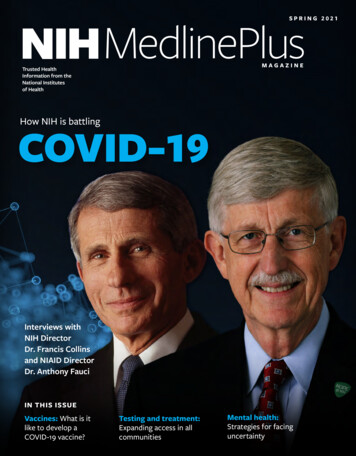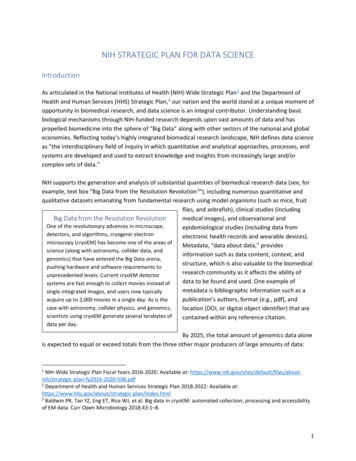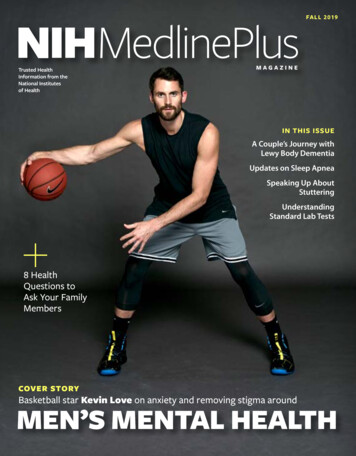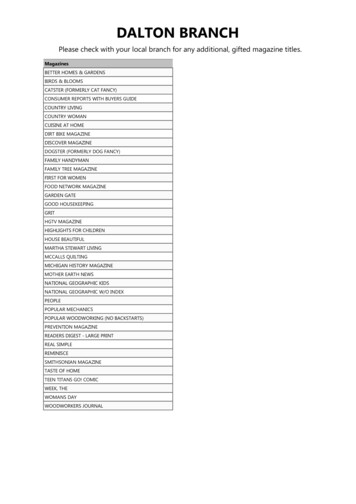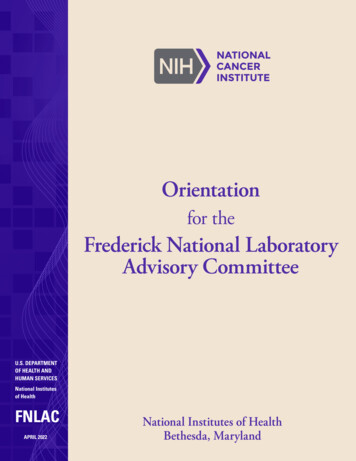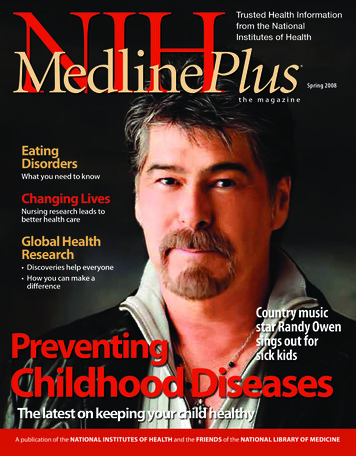
Transcription
MedlinePlusNIHTrusted Health Informationfrom the NationalInstitutes of Health Spring 2008the magazineEatingDisordersWhat you need to knowChanging LivesNursing research leads tobetter health careGlobal HealthResearch Discoveries help everyone How you can make adifferencePreventingCountry musicstar Randy Owensings out forsick kidsChildhood DiseasesThe latest on keeping your child healthyA publication of the National Institutes of Health and the Friends of the National Library of Medicine
FRIENDS OF THE NATIONAL LIBRARY OF MEDICINEOSincerely,Paul G. Rogers, ChairmanFriends of the National Library of MedicineAmong those attending the NIH’s 25th anniversarycelebration of GenBank on April 7-8 were Nobel Prizewinners Dr. Rich Roberts (left) and Dr. Sydney Brenner,pioneers in genetic research.Photos: Michael Spencer, NIHn behalf of the Friends of the National Library ofMedicine (FNLM), welcome to the Spring 2008 issue ofNIH MedlinePlus magazine. We take pride in bringingyou the most up-to-date and trustworthy informationyou need to keep you and your family healthy. In the pages thatfollow, you’ll find the latest advice and research discoveries directfrom the scientists and medical experts who work for you at theworld’s leading medical and health research organization, theNational Institutes of Health (NIH).The FNLM is also working to promote and expand the availabilityof other important work carried out by the National Library ofMedicine (NLM). One such program, GenBank—which has hada dramatic impact on medical research and health care—justcelebrated its 25th year of advancing scientific discovery in April.Scientists working to unlock our genetic code were slowedbecause they often didn’t know what their colleagues aroundthe world were discovering. That all changed with the creationof GenBank, the first publicly accessible worldwide database ofgene sequences. This ability to share knowledge around the worldplayed a crucial role in allowing scientists to complete the mappingof the human genome in 2003, years ahead of schedule.The success of GenBank has helped create a whole new field ofmedicine, which has already led to new tests for breast cancer andholds great hope for preventing and better treating many of today’smost deadly diseases. That is why we need your help to make surethat NLM programs like this are promoted and expanded. To joinus in this effort, contact FNLM at the address below—and help ussupport the greatest medical library in the world.Dr. David Lipman (center), Director of the National Center forBiotechnology Information (NCBI) was among the hosts for thetwo-day event. Seated with him are Dr. Bruno Strasser (left),Professor of History of Science and Medicine at Yale University,and Dr. Takashi Gojobori, Director and Professor at the Centerfor International Biology and DNA Data Bank of Japan.How You Can Help the LibraryExtend Medical KnowledgeYou can be a part of the Friends’ mission to help educatethe health, corporate, and public communities about NIH’smany vital research initiatives.If you or your company can help to support and expandthe Library’s efforts by providing sponsorship and othercharitable donations for NIH MedlinePlus magazine’s publication and distribution, many more thousands of Americanswill gain valuable, free access to the world’s best onlinemedical library, www.medlineplus.gov.For more information, please visit www.fnlm.org or call(202) 719-8094. Written correspondence may be sent toFNLM, 2801 M Street NW, Washington, DC 20007.The FNLM is classified as a 501(c)(3) nonprofitorganization for federal tax purposes.
MedlinePlusNIH the magazinecontentsVolume 3 Number 2 Spring 2008NATIONAL LIBRARY OF MEDICINEat the NATIONAL INSTITUTES OF HEALTH8600 Rockville Pike Bethesda, MD 20894www.nlm.nih.govwww.medlineplus.govDonald A.B. Lindberg, M.D.Director, NLMBetsy L. Humphreys, M.L.S., A.H.I.P.Deputy Director, NLMDonald West King, M.D.Deputy Director for Researchand Education, NLMKathleen CravediDirector, Office of Communicationsand Public Liaison, NLMElliot Siegel, Ph.D.Associate Director for Health InformationPrograms Development, NLMNaomi Miller, M.L.S.5Photo: St. Jude Children’s Research Hospital, Seth DixonManager of Consumer Health Information, NLMPatricia CarsonSpecial Assistant to the Director, NLMChristopher KloseMagazine CoordinatorPeter ReineckeStrategic Advisor, NLMPaul G. RogersChairman, Friends of the National Library of Medicine (FNLM)Kathy WhiteCo-Chair, Corporate & Annual Event Fundraising Development CommitteeFNLM Board of Directors(If you are interested in providing a sponsorship or other charitable donationto support and extend the reach of this publication, please contactKathy White at (336) 547-8970, x 3327 or kathy.white@vitality.com)Friends of the NLM2801 M Street NW, Washington, DC 20007NIH MedlinePlus Magazine Editorial BoardDon Detmer, M.D. Jordan Cohen, M.D. The Hon. Paul G. RogersJay Sanders, M.D. Barbara Redman, Ph.D. Roger Bulger, M.D.Kenneth Forde, M.D. Leslie Kuhn, M.D.Selby Bateman, Ginny Gaylor, Managing EditorsJan McLean, Creative DirectorTraci Marsh, Production DirectorNIH MedlinePlus, the Magazine is published byVitality Communications407 Norwalk St.Greensboro, NC 27407(336) 547-8970William G. Moore, PresidentPat Blake, ControllerPat Schrader, Administrative AssistantArticles in this publication are written by professional journalists.All scientific and medical information is reviewed for accuracy by representativesof the National Institutes of Health. However, personal decisions regarding health,finance, exercise, and other matters should be made only after consultation with thereader’s physician or professional advisor. Opinions expressed herein are notnecessarily those of the National Library of Medicine.Photos without credit lines are provided by NIH. Letter from Friends of the NLMInsideFrontCoverChairman Paul G. Rogers2 From the Director:Elias Zerhouni, M.D.5 Childhood Diseases:What Parents Needto Know10-16 Special Section:Good Health Isa Global Issue1017 Understanding EatingDisordersPhoto: ICDDR,B20 Changing Lives: The National Instituteof Nursing Research24 Then & Now:Medical Research26 GenBank Celebrates25 Years29 NIH Quickfinder andNIH MedlinePlusAdvisory Group26Cover Photo: Joe HardwickPhoto: Michael Spencer, NIHwww.medlineplus.gov Spring 2008 1
FROM THE NIH DIRECTORA GlobalHealth SystemRecently, NIH Director Dr. Elias Zerhouni traveled extensively inIndia, Africa, Pakistan, and Afghanistan, discussing with medical expertsand government officials the issues of world health and NIH’s global outreach. He spokewith MedlinePlus’ Christopher Klose on these topics.What are the major challenges facing medical research intoday’s increasingly interconnected world?rather find out much earlier—and do something about it. That’spreemptive medicine.Dr. Zerhouni: We need a health system for the world, not ahealthcare system.We cannot continue to practice the medicine of today 30years from now. Treatment is often too late and very expensive.Thanks to today’s science, we understand that a stroke, heartattack, or cancer begins years before it occurs. We can intervene.If someone is going to develop Alzheimer’s or diabetes, I wouldWith resources growing scarce, how are you going to changethe old, curative model?2 Spring 2008 NIH MedlinePlusDr. Zerhouni: The science has advanced to the point where wecan become more preventative. Also, the landscape of disease haschanged. In developing countries you now see the diseases of therich—heart disease, high blood pressure, diabetes. We must strike
“Science knowsno frontiers.”the people tested. Turns out they shared a certain gene the majority being tested didn’t, but which happens to be common to 40percent of Asian populations. Such discoveries will lead to moreeffective, less-costly treatment that is personalized and pre-emptive. But this will require global participation.Under your leadership,NIH funding for international research has risensignificantly. How doesthis benefit the Americantaxpayer?Photo: NIHDuring his recent visit to India, NIH Director Dr. Elias Zerhouni(left) met with Manmohan Singh, Prime Minister of India, todiscuss NIH’s substantial medical research collaborationswith India.them before they take us.This means being more predictive of knowing who is morelikely to be at risk and why so that we can intervene on theirbehalf. But being predictive will require medicine to becomepersonalized.Could you give an example of personalized medicine?Dr. Zerhouni: NIH-funded researchers discovered that a newlung cancer drug worked beautifully—but only on 10 percent ofDr. Zerhouni: Diseasesknow no borders anymore.SARS [severe acute respiratory syndrome] spreadthrough the world in amatter of days. The dangersof fast-moving infectiousdiseases require us to havea global vision. Without aworldwide network of welltrained, qualified scientificcollaborators, we won’t havethe radar to protect theAmerican public fromemerging and re-emerginginfections, like pandemicflu. That’s why it was veryimportant to increase ourpresence around the world.Second, the world is going to grow to nine billion people in2050, but not equally. In the developing world, people will continue to contract diseases like malaria. They will also suffer as wedo from obesity, diabetes, and heart disease.From the American taxpayer’s standpoint, therefore, I’m interested in what we can learn from studying countries that are wherewe were 30 years ago. These are natural laboratories. Perhaps,together we can discover what causes obesity and fix it. This is whywe must collaborate and train scientists worldwide.Science knows no frontiers.Are you encouraged by what is happening around the world toimprove peoples’ health?Dr. Zerhouni: On my recent trip to Africa, India, Pakistan, andAfghanistan, I was pleased to find that NIH, especially the FogartyInternational Center, is playing an essential role. So many localdoctors told me proudly they had been Fogarty Fellows. In Afriwww.medlineplus.gov Spring 2008 3
water, thereby eliminating the diarrheathat ails so many, many children.You’ve been quoted as saying, “Finding better ways of educating the worldis the best vaccine out there.” What doyou mean?Dr. Zerhouni receives a bouquet from Indian Minister of Health and Family WelfareDr. Anbumani Ramadoss. Dr. Roger Glass (left) is Director of theNIH Fogarty International Center.Photo: NIHca, especially, there is good news. We have the Gates Foundationand its commitment to global health. We also have the Presidential Plan for AIDS Relief and the Global Fund for AIDS, Malaria,and Tuberculosis. Billions of dollars have been mobilized to findnew cures and treatments.Most important was how dedicated the people are to theirown countries and cultures, and their degree of knowledge andskills. It is essential for global health that we have such expertsand that NIH continue to provide support.Is this fulfilling what you term NIH’sglobal responsibility to health?How do you see communicationshelping to change today’s healthcareinto the predictive, personalized health system you envision?Dr. Zerhouni: Medicine of the future is going to be predictive,personalized, pre-emptive, and—participatory, which meansnetworks of like-minded people with the same disease workingtogether, understanding and educating each other across theworld. This will require people to participate in their own careto the greatest extent possible, and for communities to be committed to assuring their children don’t become obese at age 12“ Finding better ways of educating the worldis the best vaccine out there.”Dr. Zerhouni: Absolutely. We are allresponsible for making medicine different in 2030. It’s a race against time, and winning depends onleadership—here and abroad—and the sense that we all benefitbecause we are interdependent.A new exhibition at the National Library of Medicine,“Against the Odds: Making a Difference in Global Health,”celebrates some of the key leaders in the global health revolution. How can the average American help to improve healthcare in other countries?Dr. Zerhouni: Americans should be proud of what they dothrough their tax dollars and their volunteering. In Uganda, Imet an oilman from Texas. He’d known nothing about infectiousdiseases, but had come to help because he “knew somethingabout drilling wells.” I’ll say! On his own time and money, he’sset up a very beneficial program. Going from village to village,he tests the water and drills the wells that provide safe drinking4 Spring 2008 NIH MedlinePlusDr. Zerhouni: Yes. For example, thereare regions where people believe thatmalaria comes from ripened fruit. Amosquito net makes absolutely nosense for protecting their children; theywant it for fishing. Knowledge is powerand education is essential to goodpublic health. If you know that waterconveys disease, then you know to filterthe water.and suffer the lifelong consequences.This cannot happen without transparent, multi-source communication, and connectedness.Are there any examples of how communication and networking through the Internet have helped people?Dr. Zerhouni: Cystic fibrosis is a great example of people inisolation who, by coming together and communicating, havehelped the science and themselves. Their life expectancy is muchlonger, the quality of life much higher, and we’re not giving upon a cure.That’s really what the NIH is involved in: connecting aroundthe world.
Childhood DiseasesWhat Parents Need to KnowDuring the passage from infancy to young adulthood, all children get sick at some point.For most American children, however, sickness is much less frequent, traumatic, and life threateningthan it was just several decades ago. Research by a number of NIH institutes and centers is continuing toimprove the outlook for childhood diseases every day.When the Eunice Kennedy Shriver NationalInstitute of Child Health and HumanDevelopment (NICHD) was established at theNational Institutes of Health 45 years ago, theworld of children’s health was a very different place than it is today.Since then, NICHD research has helped improve the health andwell being of children at every age of development.“Since the NICHD was founded,” says NICHD Director DuaneAlexander, M.D., “our research has contributed to the decline ininfant mortality of more than 70 percent, the 93 percent reductionin the rate of mother-to-child transmission of the AIDS virus, theelimination of five major causes of mental retardation, successfultreatments for infertility, an effective intervention for reducing amajor cause of premature birth, and many other benefits.”Other NIH Institutes have also contributed to those positiveresults. They are also mirrored in the ongoing improvements inU.S. childhood infectious disease rates, and those for noncommunicable diseases in children. Today, parents and theirchildren’s doctors know far more about how to prevent and, whennecessary, treat the entire range of childhood diseases.Common Childhood InfectionsChildren encounter many infectious diseases, especially in theearly months and years of life. Some upper respiratory viral orbacterial infections—such as colds, bronchiolitis, or croup—arequite common and difficult to avoid. The same can be said for earinfections, sinusitis, impetigo (skin infection), and conjunctivitis(pinkeye).Beyond these childhood infections, however, there is one wordwww.medlineplus.gov Spring 2008 5
that stands for much of the progress in battling children’sinfectious diseases. That word is “vaccines.” Vaccines have beenincredibly effective in preventing childhood diseases andimproving child mortality rates.For example, vaccinating your child against diphtheria,tetanus, and pertussis can be done in one dose. Diphtheria is aserious bacterial infection that leads to breathing problems.Pertussis is another name for whooping cough, and it hindersbreathing and eating. Tetanus is a serious bacterial infectionthat can be fatal if not prevented or treated.VaccinesStop IllnessTo prevent the spread of disease, it ismore important than ever to vaccinateyour child.IThanks to a vaccine, the United States is one of the onlyplaces in the world where polio is completely eradicated. Oneshot is all it takes to prevent this paralyzing condition. Gettinga flu shot and a pneumonia vaccine are also recommendedfor infants six months or over. They are the most vulnerablewhen it comes to these diseases. A certain strain ofpneumonia can lead to blood infections and meningitis,which is covered in the vaccine.Similarly, the MMR vaccine protects against measles,mumps, and rubella, viral infections that cause serioussymptoms. Measles and mumps often can lead to chronicconditions, such as deafness, brain damage, and reproductiveproblems. Rubella is also known as the German measles, andcauses fever.The vaccination chart that follows offers a simpleoverview of what childhood vaccines to take, when totake them, and why.To Find Out MoreSearch for “childhood immunization” or“shots” on medlineplus.gov. Or visit theCenters for Disease Control and Prevention atwww.cdc.gov/vaccines for more information.6 Spring 2008 NIH MedlinePlusn the United States, vaccines have reduced or eliminatedmany infectious diseases that once routinely killed orharmed many infants, children, and adults. However, theviruses and bacteria that cause vaccine-preventable diseaseand death still exist and can be passed on to people who are notprotected by vaccines. Vaccine-preventable diseases have manysocial and economic costs: sick children miss school and cancause parents to lose time from work. These diseases also resultin doctor’s visits, hospitalizations, and even premature deaths.Some diseases (like polio and diphtheria) are becoming veryrare in the United States. Of course, they are becoming rarelargely because we have been vaccinating against them. Unlesswe can completely eliminate the disease, it is important to keepimmunizing. Even if there are only a few cases of disease today, ifwe take away the protection given by vaccination, more andmore people will be infected and will spread disease to others.We don’t vaccinate just to protect our children. We alsovaccinate to protect our grandchildren and their grandchildren.With one disease, smallpox, we eradicated the disease. Ourchildren don’t have to get smallpox shots any more because thedisease no longer exists. If we keep vaccinating now, parents inthe future may be able to trust that diseases like polio andmeningitis won’t infect, cripple, or kill children.Vaccine SafetyIn light of recent questions about vaccine safety, the Centersfor Disease Control and Prevention (CDC) has offered thefollowing information for parents:“Vaccines are held to the highest standard of safety. TheUnited States currently has the safest, most effective vaccinesupply in history. Law requires years of testing before a vaccinecan be licensed. Once in use, vaccines are continually monitoredfor safety and efficacy. Immunizations, like any medication, cancause side effects. However, a decision not to immunize a childalso involves risk. It is a decision to put the child and others whocome into contact with him or her at risk of contracting a diseasethat could be dangerous or deadly. The CDC and the Food andDrug Administration (FDA) continually work to make alreadysafe vaccines even safer.” In the rare event that a vaccine injures achild, he or she may be compensated through the NationalVaccine Injury Compensation Program (VICP); call1-800-338-2382.”
!Clip and SaveChildhood Vaccine ScheduleWhen to VaccinateWhat VaccineWhyBirth (or any age if not previously immunized)Hepatitis B (HBV) (three doses)—HepBPrevents hepatitis B, a type of liver disease that can lead to liver scarring,cancer, or failure1 to 4 MonthsHepBClip and Save!2 MonthsDiphtheria, tetanus and acellular pertussis—DTaPPrevents:Diphtheria, a serious bacterial infection that can lead to breathing problemsTetanus, a bacterial illness that causes a painful tightening of the muscles,such as “lock jaw”Pertussis (Whooping cough), an infectious bacterial disease that causesuncontrollable coughingHaemophilus influenza type b vaccine (threedoses)—HibProtects against illnesses like meningitis, pneumonia, and infections of theblood, bones, and jointsInactivated poliovirus vaccine —IPVProtects against polio, a contagious, paralyzing, and life-threatening diseasePneumococcal conjugate vaccine—PCVProtects against the pneumococcal bacterium, the leading cause of infections such as pneumonia, blood infections, and bacterial meningitisRotavirus vaccine (three doses)—RVProtects against severe diarrhea, mostly in babies and young children4 MonthsDTaP, Hib, IPV, PCV, RV6 Months and AnnuallyInfluenza – Flu vaccine or flu “shot” (two doses,one month apart, for those under 9 getting a flushot for the first time)6 MonthsDTaP, Hib, PCV, RV6 – 18 MonthsHep B, IPVProtects against seasonal fluHib, PCVMeasles, mumps and rubella (German measles)vaccine—MMR12 – 15 MonthsA “3 in 1” vaccine against three potentially life-threatening diseases:Measles, a virus that causes a rash, cough, runny nose, eye irritation, andfeverMumps, a virus causing fever, headache, and swollen glands; can lead todeafness, meningitis, swollen testicles or ovaries, and death in some casesRubella, also known as German measles. A generally mild disease, it cancause serious birth defects in the child of a woman who becomes infectedwhile pregnantVaricella (chickenpox) vaccine—VarProtects against chickenpox, a usually mild infectious disease characterizedNote: In February 2008, the Advisory Committee by an uncomfortable, itchy rash, fever, and headache; in adults, can causeon Immunization Practices (ACIP) changed itsshingles and other serious problemsrecommendations. It had recommended givingthe MMR and Varicella vaccines at the same time.Now it does not express a preference for givingthem separately or at the same time.12 – 23 MonthsHepatitis A vaccine (two doses) —Hep A15 – 18 MonthsDTaP4 – 6 YearsDTaP, MMR, IPV, VarClip and Save!Human papillomavirus vaccine—HPV11 – 12 YearsIn young girls, prevents most cases of genital warts and cervical cancerTetanus, diphtheria and pertussis booster—TdapMeningitis vaccine—MCVCollege EntrantsProtects against a type of liver diseaseProtects against meningitis, an inflammation of the thin tissue surroundingthe brain and spinal cord; there are several types of meningitisMeningitis vaccine for college aged—MCV4Protects against meningitis, recommended for previously unvaccinatedcollege entrants planning to live in dormitories.(Sources: medlineplus.gov; U.S. Centers for Disease Control; CDC Advisory Committee on Vaccine Practices)www.medlineplus.gov Spring 2008 7
Randy Owen spends many hours visitingwith the children receiving treatments atSt. Jude Children’s Research Hospital.“Braid My Hair”Randy Owen sings out for sick childrenFor more than 25 years, Randy Owen led one of countrymusic’s most popular groups, Alabama. After sellingmore than 73 million albums with 42 number onesingles, Owen has begun a solo career.Owen is about more than music, however. In 1989, he helpedstart the Country Cares for St. Jude Kids program after meetingDanny Thomas, founder of St. Jude Children’s ResearchHospital . The Country Cares radio fundraising events haveraised 315 million in the past 19 years.Owen’s debut performance of his latest song, “Braid My Hair,”was the highlight during this year’s Songwriter’s Dinner heldannually at St. Jude.A Special Song“Braid My Hair” is the first single from Owen’s new solo album,8 Spring 2008 NIH MedlinePlusOne to One. The song is about a young girl who has lost her hairdue to illness. Chris Gray and Brent Wilson wrote the song. Grayhad been a teacher at St. Jude helping kids there who were beingtreated for cancer and other catastrophic childhood diseases. Heknew firsthand the effects chemotherapy had on kids and thatmany of the girls longed to have hair to braid again. Thesongwriters managed to get the song to Owen’s mother, whorecommended her son listen to it.One hundred percent of the song’s publishing royalties will bedonated to St. Jude Children’s Research Hospital. “It’s an incrediblestory done in song,” says Owen. “To kick this album off with thissong is definitely the right way to go.”It is easy to see that Owen’s commitment to St. Jude is ongoing.He was honored last June by Danny Thomas’ son, Tony, with thehospital’s Founders Award. In accepting the award, Owencelebrated Danny Thomas’ work, saying “I didn’t have the chancePhoto: St. Jude Children’s Research Hospital, Seth DixonThe Friends of theNational Library ofMedicine (FNLM) recentlypresented Randy Owentheir Paul G. RogersPublic Service Award.This award was createdto honor individualswho are demonstratedleaders in increasingawareness and supportof important healthissues today. The FNLM ispleased to honor RandyOwen for his many yearsof dedication to St. JudeChildren’s ResearchHospital and children’shealth issues.
Good News About Childhood CancerThere has been a vast improvement in survival rates for children with cancer. There is now a five-year survival rate of morethan 85 percent for the most common form of childhood cancer (acute lymphoblastic leukemia or ALL).During the last 20 years both the five-year survival rates and death rates have declined for most childhood cancers. Bothdecreases are due to major progress in treatment. These decreases are even more impressive when they are considered with thefact that the rate of children diagnosed with all forms of invasive cancer has actually increased during the same time period.Still more than 1,500 children die every year from cancer while about 10,400 children under 15 are diagnosed with thedisease. Cancer remains the leading cause of death by disease among U.S. children 1 to 14 years of age.Current childhood cancer research at St. Jude includes: gene therapy, bone marrow transplant, chemotherapy, thebiochemistry of normal and cancerous cells, radiation treatment, blood diseases, resistance to therapy, hereditary diseases andthe psychological effects of catastrophic diseases.The Latest ResearchThe National Cancer Institute (NCI) funds a large number of studies that look at the causes of and the most effectivetreatments for childhood cancers. Ongoing investigations at NCI include:77 Studies to identify causes of the cancers that develop in children77 Monitoring of U.S. and international trends in incidence and death rates for childhood cancers77 Studies to better understand the biology ofPhoto: Joe Hardwickchildhood cancer77 Preclinical studies (animal studies) of new agents toidentify promising anticancer drugs that can be evaluatedin clinical trials77 Projects designed to improve the health status of survivorsof childhood cancers77 Clinical trials to identify better treatments forchildhood cancers77 Evaluations of new drugs that may be more effectiveagainst childhood cancers and that may have less toxicityfor childrento know him as well as some of you, but it shows you how a goodman can inspire you in just a brief time.”Hospitals for ChildrenIn all there are about 250 children’s hospitals in the UnitedStates. For more information on children’s hospitals, visit www.childrenshospitals.net, the Web site for the National Association ofChildren’s Hospitals and Related Institutions (NACHRI).NACHRI is an organization of children’s hospitals with 218members in the United States, Canada, Australia, the UnitedKingdom, Italy, China, Mexico, and Puerto Rico.Former Alabama lead singerRandy Owen sings his newsong, “Braid My Hair.”To Find Out MoreVisit www.countrycares.org to hear Randy Owensing his new single “Braid My Hair.”www.medlineplus.gov Spring 2008 9
S P E C I A LS E C T I O NGood HealthIs a Global IssueNIH-supported medical research and training advance health worldwidePhoto: Fogarty International CenterDr. Roger Glass, Director of the NIH FogartyInternational Center, on a visit to Africa tosee Fogarty-supported projects in action.Changing Patterns of DiseaseToday, thanks to public healthmeasures and biomedical advancesworldwide, life expectancy andprosperity are generally increasing acrossthe developing world. The majorexception is sub-Saharan Africa, whichcontinues to be heavily affected by AIDS,malaria, tuberculosis, childhooddiarrhea, and respiratory diseases.But along with getting older, peopleare becoming vulnerable to noncommunicable chronic diseases,including cancer, diabetes, heart disease,and the risk factors that cause them.Social and economic changes, such asmigration to cities, adoption of moresedentary lifestyles, rich diets, smoking,and addictions add further risk factors toa healthy life.For those reasons, many of the research efforts related to globalhealth must now deal with these non-communicable and chronicdiseases, in addition to the traditional infectious diseases in thedeveloping world.Fogarty at 40For the past four decades, the Fogarty International Center atthe National Institutes of Health has been a leader in promotingand funding international medical research and training. Thebenefits for everyone—including Americans—have been many.Now, health problems and priorities are changing, and Fogarty ishelping to train medical researchers around the globe to meet newchallenges. The idea that the United States could benefit frominternational research was central to the creation of the Fogarty10 Spring 2008 NIH MedlinePlusInternational Center in 1968. John E. Fogarty, the Rhode IslandCongressman for whom the Center is named, predicted thatinternational studies in the health sciences would pay doubledividends: the research would help build healthier, more politicallyand economically stable societies overseas, and U.S. citizens wouldreap the benefits of international discoveries.Today, Fogarty funds approximately 400 projects awarded toboth foreign and U.S. institutio
rich—heart disease, high blood pressure, diabetes. We must strike FROM THE NIH DIRECTOR A Global Health System Recently, NIH Director Dr. Elias Zerhouni traveled extensively in India, Africa, Pakistan, and Afghanistan, discussing with medical experts and government officials the issues of world health and NIH's global outreach. He spoke
